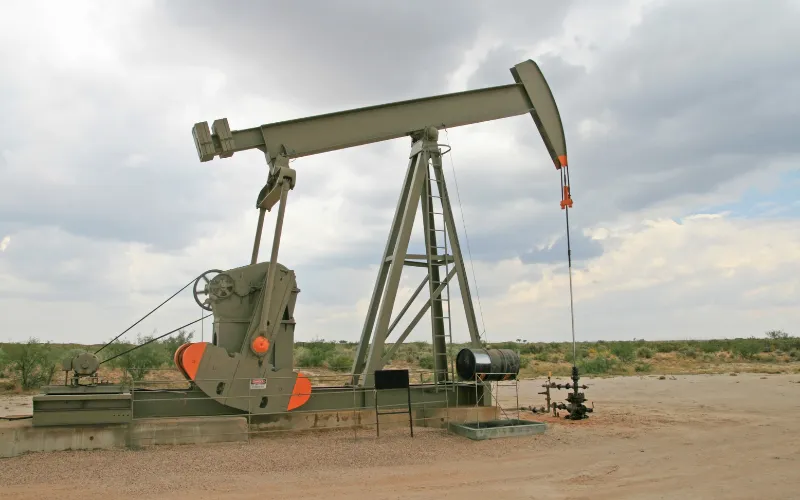The worldwide oil and gas sector produces, processes and sells petroleum and natural gas.
This industry works in with a process that includes finding, drilling and extraction of oil and gas from beneath the ground as well as the refining and delivery of these products to clients.
This industry is the back bone of global economy and supplies a sizable amount of the world’s energy requirements.
This blog provides in-depth review of how much money you can make from an oil well.
We’ll go through the elements that influence oil well output and earnings as well as the many types of oil wells and how much money can be made from each.
And also, the possible hazards and limitations of oil well profitability as well as how to invest in oil wells.
What is an Oil Well?

An oil well is a hole bored into the soil to produce oil or natural gas from underground reservoirs.
Oil wells are often found in oil and gas-rich regions such as the Middle East, North America and Russia.
The size and depth of oil wells vary and their productivity and profitability are controlled by a variety of factors.
Also See: How To Make Money with Solar Panels?
Types of Oil Wells
1. Conventional Oil Wells
A conventional oil well is the most common type of oil well which extracts oil and gas from underground reservoirs using traditional drilling methods.
These wells can produce oil and gas for several years before production begins to decline.
2. Unconventional Oil Wells
Unconventional oil wells extracts oil and gas from unconventional sources such as shale formations and tar sands.
These wells produce oil and gas from subsurface rock formations using hydraulic fracturing and other modern drilling techniques.
Unconventional wells have greater production costs but can yield considerable quantities of oil and gas.
3. Offshore Oil Wells
Offshore oil wells are installed in oceans and seas to extract oil and gas from the seabed.
These wells are more expensive to operate but they produce a considerable amount of oil and gas.
Offshore wells are classified as shallow water or deep water based on their depth below the sea surface.
How Much Money Can You Make from an Oil Well?
| Factor | Details |
|---|---|
| Production Rate | The amount of oil produced per day |
| Oil Price | The market value of a barrel of oil |
| Production Cost | The expenses incurred to extract and transport the oil |
| Royalty | A percentage of the revenue paid to the mineral rights owner |
Based on these factors, the earnings from an oil well can vary greatly. Here is an example calculation:
| Factor | Example Value |
|---|---|
| Production Rate | 500 barrels per day |
| Oil Price | $60 per barrel |
| Production Cost | $20 per barrel |
| Royalty | 20% |
Using these values, the calculation for daily revenue would be as follows:
Revenue per barrel = Oil price – Production cost
Revenue per barrel = $60 – $20
Revenue per barrel = $40
The calculation for daily revenue would be as follows:
Daily revenue = Production rate x Revenue per barrel
Daily revenue = 500 barrels per day x $40 per barrel
Daily revenue = $20,000 per day
The calculation for monthly revenue would be as follows:
Monthly revenue = Daily revenue x 30 days
Monthly revenue = $20,000 per day x 30 days
Monthly revenue = $600,000 per month
The calculation for annual revenue would be as follows:
Annual revenue = Monthly revenue x 12 months
Annual revenue = $600,000 per month x 12 months
Annual revenue = $7,200,000 per year
Annual Potential Earnings from an Oil well according to different locations:
| Scenario | Potential Earnings |
|---|---|
| Small, low-yield well in a remote location | $10,000 – $50,000 per year |
| Medium-sized well in a moderately productive area | $100,000 – $500,000 per year |
| Large, high-yield well in a highly productive area | $1 million – $10 million per year |
| Ultra-deepwater well with high initial investment and long-term production potential | $100 million or more over the life of the well |
Case Studies of Profitable Oil Wells
Around the world, there are several examples of productive oil wells.
Some of the most well-known oil-producing regions are:
- Permian Basin in Texas and New Mexico,
- Bakken Formation in North Dakota and Montana, and
- Eagle Ford Shale in Texas.
These places have produced enormous volumes of oil and gas, resulting in significant revenues for oil firms and investors.
Also See: 10 profitable ways to make money from your land?
Estimating Oil Well Profits
Estimating the profitability from an oil well involves calculating the well’s income and subtracting the production expenses, taxes and royalties.
The income from an oil well is normally determined using the amount of oil and gas produced as well as the market pricing for these goods.
The costs of drilling, finishing and maintaining the well are included in the production costs whereas taxes and royalties are payments paid to governments for the right to produce oil and gas.
Potential Risks and Limitations of Oil Well Profitability
Oil well profitability is subject to several risks and limitations such as natural disasters, price fluctuations and geopolitical events.
Additionally, the expenditures of drilling and maintaining an oil well might be prohibitively expensive and reserves may ultimately run out resulting in decreasing output and profitability.
Furthermore, regulatory changes and environmental concerns can also affect the profitability of an oil well.
Factors That Affect Oil Well Production and Profits

1. Reserves
The amount of oil and gas reserves in an oil well is one of the primary factors that determine its production and profitability. The larger the reserves, the more oil and gas the well can produce, and the more money it can generate. The quality of the oil and gas reserves, such as their purity and viscosity, also affects the production and profitability of the well.
2. Production Costs
The costs of drilling, finishing and maintaining an oil well are included in the production costs.
Labor, equipment and materials expenses for these procedures might vary greatly based on location and kind of well.
The higher the manufacturing expenses, the smaller the well earnings.
3. Market Prices
Another important aspect influencing the profitability of an oil well is the market price of oil and gas products.
The more money the well can create, the higher the market values.
Oil and gas market prices are also impacted by some other factors such as global demand, supply and geopolitical events.
Also See: How to Make Money from Property Development?
4 Taxes and Royalties
The taxes and royalties imposed by governments on oil and gas production can significantly affect the profitability of an oil well.
Taxes and royalties can vary greatly depending on the location and type of well and they can account for a large amount of the well’s earnings.
5. Location
The location of an oil well can also affect its production and profitability.
Wells located in areas with high geological potential and low production costs tend to be more profitable than those in areas with lower potential and higher costs.
Additionally, the distance of the well from the market and transportation infrastructure can affect its profitability.
Investing in Oil Wells

Types of Oil Well Investments:
Investing in oil wells can take several forms such as direct ownership, joint ventures, royalties and oil & gas funds.
Direct ownership involves owning a stake in an oil well, while joint ventures involve partnering with an oil company to develop an oil well.
Royalties are payments given to mineral rights holders for the ability to produce oil and gas from their property, whereas oil and gas funds are investment entities that collect money from investors to participate in oil and gas projects.
Factors to Consider:
When Investing in Oil Wells Investing in oil wells carries certain risks and requires careful consideration of various factors such as the investment size, risk tolerance, operator reputation and geopolitical risks.
The type of investment and the investor’s financial means will decide the amount of investment, whilst risk tolerance relates to the investor’s willingness to take risks.
The reputation of the operator is essential in ensuring that the oil well is developed and managed properly.
Geopolitical risks refer to the political and economic risks associated with the country or region where the oil well is located.
Average Oil Royalty payments
| Country | Average Oil Royalty Payment |
|---|---|
| Saudi Arabia | 15% of oil revenue |
| Russia | 11-13% of oil revenue |
| United States | 12.5% to 20% of oil revenue |
| Canada | 27% of oil revenue |
| Iraq | 25% of oil revenue |
| Kuwait | 15% of oil revenue |
| United Arab Emirates | 20% of oil revenue |
| Venezuela | 20% of oil revenue |
| Nigeria | 12–25% of oil revenue |
| Norway | 25% of oil revenue |
Also See: 10 ways to make money from EV Charging Station?
Conclusion
Oil well profitability depends on various factors such as reserves, production costs, market prices, taxes and royalties and location.
There are different types of oil wells including conventional, unconventional and offshore wells, each with its advantages and limitations.
Estimating oil well profits requires calculating the revenue and deducting the production costs, taxes, and royalties. Investing in oil wells can take various forms and requires careful consideration of several factors.
Readers interested in learning more about the oil and gas sector and investing in oil wells may find the following sites useful:
- American Petroleum Institute (API)
- Oil and Gas Investor
- Energy Information Administration (EIA)
- Oil & Gas Journal
- Society of Petroleum Engineers (SPE)
FAQs
How much can I make from an oil well?
The profit potential of an oil well ranges from $10,000 to $1,000,000. It fluctuates greatly based on location, production levels and market circumstances.
How much money does an oil rig make per day?
The overall income for a tiny 100 barrel per day business might range from $5,000 to $2.5 million per day.
How much money does an oil rig make per year?
On average, it can range from $300,000 to $50 million per year
How much is an oil well worth?
Oil wells can be worth millions or even billions of dollars which depend on factors such as its production capacity, location and market conditions.
How much money do oil companies make?
In 2020, the top five oil companies – ExxonMobil, Chevron, BP, Royal Dutch Shell and Total energies had a combined revenue of over $1.2 trillion.
How much do oil companies pay to drill on your land?
Payments per acre can range between a few hundred and several thousand dollars, with additional royalties paid dependent on the amount of oil extracted.









